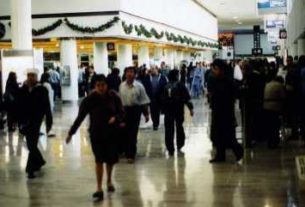Dale Hoyt Palfrey
With the rise of a variety of highly developed cultures, Mesoamerica entered its Golden Age. It was an era marked by political, intellectual and urban development, as well as excellence in monumental architecture and the creative arts. Teotihuacan, Cholula, Monte Alban and the foremost Mayan centers all reached their heights in this period.
Religion was the unifying factor of Classic societies in which the sacerdotal class assumed leadership in politics, science and culture. Cult was rendered to a complex pantheon including gods and goddesses of the sun, moon, rain, water, fire and corn, in addition to the ubiquitous Plumed Serpent known in Nahuatl as Quetzalcoatl.
Teotihuacan
The first great highland culture of the Classic period had its capital at Teotihuacan, the “City of the Gods” located about 30 miles northeast of Mexico City. At its height, this was a teeming metropolis of 100,000 or more inhabitants, with a well defined class structure. Its people had knowledge of writing and books, a bar-and-dot number system, and a 260-day sacred calendar. A society seemingly based on agriculture, obsidian mining and trade, Teotihuacan held widespread influence throughout Mesoamerica.
While only a fraction of the zone has been excavated, the remains of the civic-ceremonial center alone cover an area of more than two square miles. Built on a grid plan, it includes a variety of imposing pyramids, temples and single story palaces lining the two-mile long Avenue of the Dead. The site is noted for the uniformity of its architectural style and the unique “talud-tablero” building technique in which sloping walls were faced with decorative panels
The most prominent structures are the Pyramid of the Sun, the third largest pyramid in the world, and the slightly smaller Pyramid of the Moon. At the southern extreme of the Avenue of the Dead lies the “Ciudadela” complex that includes the Temple of Quetzalcoatl. Palaces where the city’s lords and priests probably resided are located throughout the site. Many of these were adorned with colorful frescoes, including a whimsical depiction of Tlalocan, the Paradise of the Rain God Tlaloc.
Teotihuacan was deliberately burned and plundered in the 7th century, its influence elsewhere suddenly ceasing. The perpetrators and motives of the great city’s demise remain a mystery. Yet its aura as a most sacred site survived to the era of the Aztecs and even to the present.
Published or Updated on: January 1, 1997

